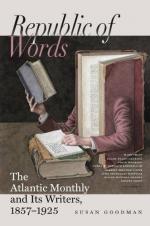But the year goes on. Our fitful and capricious spring passes by, and summer takes its place. But our New-England summer is not like the summer of Thomson and Cowper, and images drawn from English poetry and transplanted here would be out of place; and our faithful interpreter of American Nature takes nothing at second-hand. How correctly he delineates the characteristic features of our glorious month of June!
“There, through the long, long summer
hours,
The
golden light should lie,
And thick young herbs and groups of flowers
Stand
in their beauty by.
The oriole should build and tell
His love-tale close beside my cell;
The
idle butterfly
Should rest him here, and there be heard
The housewife-bee and humming-bird.”
The housewife-bee is an expressive epithet. Does it involve a double meaning, and insinuate that as a bee carries a sting, so women who are stirring, notable, and good housekeepers have something sharp in their natures?
Next comes midsummer with its fervid and overpowering heats, which find in our poet also an accurate delineator.
“It is a sultry day: the sun
has drunk
The dew that lay upon the morning grass;
There is no rustling in the lofty elm
That canopies my dwelling, and its shade
Scarce cools me. All is silent, save
the faint
And interrupted murmur of the bee,
Settling on the sick flowers, and then
again
Instantly on the wing. The plants
around
Feel the too potent fervors: the
tall maize
Rolls up its long green leaves; the clover
droops
Its tender foliage, and declines its blooms.
But far in the fierce sunshine tower the
hills
With all their growth of woods, silent
and stern,
As if the scorching heat and dazzling
light
Were but an element they loved.”
But our radiant and many-colored autumn is Bryant’s favorite season, and some of his most beautiful and characteristic passages are those which paint its hues of crimson and purple, and the vaporous gold of its atmosphere. Such is the number of these passages that it is difficult to make a selection of one or two for quotation. Here is one from “Autumn Woods.”
“Let in through all the trees,
Come the strange
rays; the forest-depths are bright;
Their sunny-colored foliage, in the breeze,
Twinkles like
beams of light.
“The rivulet, late unseen,
Where bickering
through the shrubs its waters run,
Shines with the image of its golden screen
And glimmerings
of the sun.
“But, ’neath yon crimson tree,
Lover to listening
maid might breathe his flame,
Nor mark, within its roseate canopy,
Her blush of maiden
shame.”
Here is nothing imitative or borrowed, and here are no unmeaning generalities. Everything is exact and local,—drawn from an American autumn, and no other. And how lovely an image is that in the third stanza, and what an added charm it gives to an object in itself most beautiful!




